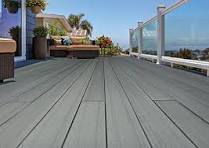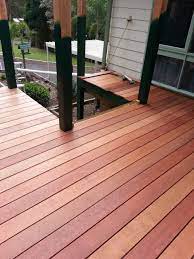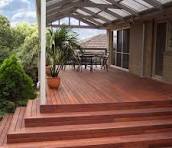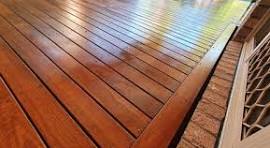Choosing The Right Decking Material
Are you in the market for an outdoor decking solution? If so, you’re likely torn between two main contenders: timber and composite. Both have their unique selling points, but which one truly stands out in terms of durability, sustainability, and cost-effectiveness? Let’s delve into a comparative analysis to shed light on this pressing question.
Composite Decking The Facts
Firstly, let’s take a closer look at the star of the show, composite decking. The primary selling point of this material is its maintenance-free nature and eco-friendly credentials. But is it really maintenance-free? To answer that, we need to understand what composite decking is made of.
Composite decking boards are a blend of wood and plastic. The wood component can range from sawdust and wood chips to wood fiber pieces. On the other hand, the plastic component can be either virgin or recycled plastic materials. The average cost of composite decking stands at around $22.00 per lineal metre, which is a bit steep compared to Merbau natural timber decking, priced at approximately $11.00 per lineal metre.
The negative Environmental Impacts
Now, the term “composite” is not just a marketing buzzword. It refers to the fact that these decking materials are not naturally grown, but rather, they are composed of various synthetic materials. These include polypropylene, polyethylene, and poly vinyl chloride. These petroleum-based products are by-products of oil manufacturers, who have a well-documented history of environmentally unfriendly practices.
Chemicals
Interestingly, the concept of composite decking arose from the need to repurpose waste. However, the production process of these materials is far from environmentally friendly. It involves harmful chemicals and energy-intensive processes, which does allow composite decking manufacturers to claim that they use recycled materials. But, let’s not forget that these materials also contribute to environmental pollution.
Let’s take a moment to consider the lifecycle of composite decking. Once these structures are demolished or damaged, where do they end up? They end up in landfills, where they will remain for hundreds, if not thousands, of years. This is far from the green image that composite decking manufacturers would like us to believe.
Another alarming issue is the non-biodegradable nature of composite materials. These materials have been known to end up in the ocean due to natural disasters like hurricanes. Once there, they sink to the bottom and remain, potentially for hundreds or thousands of years. This is a stark contrast to hardwoods like Ipe, which degrade naturally in both the ocean and landfills within about 10 years.
It’s also worth noting that plastic deck boards are non-recyclable. They can only be disposed of through incineration or landfill, which is hardly an environmentally friendly solution.

Semi Conclusion
In conclusion, while composite decking may seem like a green alternative at first glance, a closer look reveals a more complex picture. It’s crucial to consider not just the upfront cost and maintenance-free nature of composite decking, but also its environmental impact and long-term sustainability. It’s time to rethink our choices and make decisions that truly align with our values and the health of our planet.
More Drawbacks and conclusion
As we continue to explore the world of composite decking, it’s crucial to understand its potential pitfalls. Manufacturers suggest that installers allow for space at the board ends to accommodate expansion. This might sound logical, but here’s where things get a bit complicated.
Imagine this scenario: sand and grit find their way into these expansion joints. This unwanted intrusion can hinder the boards from expanding when exposed to heat. As a consequence, the boards can detach from their holding down clips, leading to potential safety concerns.
But that’s not all. Composite decking materials absorb heat at a much higher rate than timber and hold onto it for longer. This could make your decking area uncomfortably hot during sunny days.
Lastly, and perhaps most importantly, composite decking lacks the natural beauty that timber offers. It simply can’t compete with the warmth and charm that only real wood can provide.
In the end, it’s essential to weigh these factors before deciding on the right material for your decking project. Be prepared for those smooth talking sales people. Just remember one key word PLASTIC
The Timber Decking Option: A Sustainable and Elegant Choice
When it comes to decking, timber is not just a viable option, it’s a superior one. With a vast array of Australian species to choose from, each boasting its own unique beauty and charm, timber decking is a perfect blend of natural aesthetics and practicality.

To start with, let’s take a closer look at some of the most popular timber species used in decking. Spotted Gum, Jarrah, Black Butt, Stringy Bark, and Box Wood are all well-known for their distinctive characteristics. Each of these species brings its own unique blend of strength, durability, and beauty to the table.
Among these, Malaysian hardwood Merbau stands out as a particularly popular choice. Not only is it aesthetically pleasing, but it also comes with a price tag that’s significantly lower than that of composite boards. Furthermore, Merbau is quicker and easier to lay, making it an excellent choice for those looking for a cost-effective and efficient solution.

But what truly sets timber apart is its versatility. It’s not just about decking; timber has a multitude of other applications. It’s a staple in the construction industry, used for everything from framing to roofing. It’s also used for sea defences, sports equipment, and even gazebos and other garden structures.
Moreover, timber is a natural insulator. It’s five times better than concrete at retaining heat, thanks to the empty space in its cells. This means that timber can keep your outdoor space warm and cozy, even in colder months.
And let’s not forget about sustainability. Timber is a renewable resource. Trees grow naturally and can be harvested responsibly, ensuring that the forest can continue to thrive and provide us with this wonderful resource indefinitely. And, all timber is completely bio degradable.
But what about maintenance? Some might argue that timber requires too much upkeep. However, this is far from the truth. Regular oiling, which takes about four hours once or twice a year, is all it takes to keep your timber deck in top condition. It’s a small price to pay for the natural beauty and durability that timber offers.

In conclusion, timber decking is a sustainable, versatile, and aesthetically pleasing option that offers a plethora of benefits. From its natural beauty to its practicality, timber is a choice that combines form and function in the most harmonious way. So, why not consider timber for your next decking project? It’s time to embrace the timber revolution! Contact the handyman for more advice.